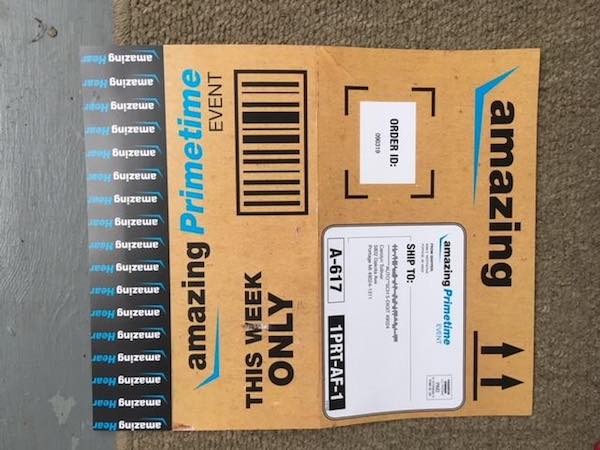If you want to grab immediate attention with direct mail, make the mailer look like something else. Mailers often use envelopes designed to look like USPS Priority Mail, Air Mail, or UPS or FedEx packages. Even if people quickly recognize them as knock-offs, they still know that those packages are special. They take extra effort to send. They cost more. As a result, they often serve their intended purpose of getting the recipient to open them. But do some efforts cross the line?
This morning, my father sent me an email with the subject line, “What do you see?” Attached was an image that looked as if he had received a package from Amazon Prime.

In a second email (so he wouldn’t spoil the surprise), he attached an image of the inside of the package, which turned out to be a promotion from Miracle Ear.

I went back to the first image. Now knowing it was not from Amazon, I could see what I couldn’t before. The package design was nearly identical to Amazon Prime’s, with the same colors, fonts, and layout, but the text actually read, “Amazing Primetime.” Below “Primetime,” in smaller letters, was “event.” Amazing Primetime event.
The package wasn’t just designed to look like a priority delivery. It was designed to look like a mailing that came from another company. The addition of the word “Prime” in “Primetime event” shows just how closely Miracle Ear was trying to trick the recipient’s eye. Especially if the recipient subscribes to Amazon Prime (which my parents do) and doesn’t look carefully, they could easily think it was something they ordered. One could see it as clever, or one could see it as a trick.
I responded to my father’s email by referencing this as part of the larger trend toward faux mailers. His response?
What they don’t realize is that people like us find it offensive. Why would I do business with someone who has been dishonest from the get-go? By trying to trick me into looking at their product, they’ve lost my business the minute their mailer hits my mailbox. I assume everything else they do follows in kind: Dishonest. Can’t be trusted. Mailer goes immediately into the trash.
It’s an interesting point worthy of discussion around the management table. What is the cost-benefit of using such techniques? They may result in short-term gain, but in the long term, do they undermine trust in the brands that send them? I think of a political mailer sent out several years ago that was designed like a court summons. The brown envelope read, “SUMMONS ENCLOSED: OPEN IMMEDIATELY.” If you Google “direct mail that tricks people,” you’ll see that the backlash was not pleasant. (The candidate did not win the election either.)
Every marketer will have to make their own decision about the value of these types of mailers, and some efforts are more sneaky than others. Some merely catch your eye long enough for the recipient to appreciate their cleverness, while others go much further. Regardless where they fall on the spectrum, these types of mailers do have proven track records of increasing open rates, but I wonder, as my father pointed out, whether they have a longer-term negative impact on the brand image and brand trust.














Discussion
By Dennis Kelly on Oct 16, 2019
Heidi, I completely agree with your point here. Research shows that print and direct mail have higher levels of trust than digital channels. DM like this erodes this huge advantage, rather than accentuates it. In a bid for response metrics, marketers may win a battle, but lose the war.
By Ray Cheydleur on Oct 16, 2019
I'm in total agreement that they will have lost my trust before I even read the rest of the message (which I won't). I've said this as well about the dozens of messages i get on my phone offering me healthcare or other services from - who responds to this kind of deception?
By Kate Dunn on Oct 16, 2019
I think there is a distinction around was it meant to "trick" the recipient or was it meant to be funny. I have seen some direct mail pieces that are clearly trying to be funny as in Bloomingdog's Pet Salon or something along those lines. The design is close but not so close that you think it's actually Bloomingdales. The example in the article is totally using Amazon branding to trick the recipient into opening something they think is from Amazon. I do think that is deceptive and not the best way to start a relationhip with a customer.
By Heidi Tolliver-Walker on Oct 17, 2019
Yesterday, I received three pieces of mail that I feel fall into this category. They all used fear and misleading tactics. FINAL NOTICE on something that looked like a bill. You're going to be contacted by our collections people. I don't remember the details because I immediately ripped them up, but clearly, there are people who fall for these tricks. Otherwise, they wouldn't do it.